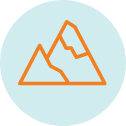Our comprehensive LHO Eiger Course offers an advanced, ridge-focused alpine itinerary designed for those seeking to elevate their skills to the next level. This meticulously crafted and flexible program is delivered by our selected IFMGA-certified guides with the support of our LHO Team Leaders. It places a strong emphasis on developing experience with exposure and efficient skills to tackle epic ridges including the Eiger's Mittellegi ridge, with the ultimate goal of summiting the Eiger and beyond!

TRIP TYPE
Climbing and Mountaineering

DURATION
7 Days

DESTINATION
The Alps
1
An all inclusive advanced alpine mountaineering experience featuring rock & ridge training and alternative routes during adverse weather, at no extra cost.
2
Features several highly sought-after summits, including Pointe Innominata and Aiguille Croux, alongside the iconic Eiger.
3
Guided by a specialised LHO Expedition Coordinator and certified IFMGA guides, ensuring a seamless, safe experience, with full support on and off the mountain.






WHAT'S INCLUDED IN THIS TRIP
WHAT'S NOT INCLUDED IN THIS TRIP
DAY 1: WELCOME TO EPIC CHAMONIX
The first day of our itinerary is the arrival day. If you’re arriving at Geneva airport, our transfer partners will meet you and take you to our hotel in the Chamonix valley. If you’re meeting us directly at the hotel, your LHO Team Leader will be waiting for you there. Check-in at our accommodation usually begins at 3 pm. If you arrive early, you can store your bags at the hotel and explore the area. Your LHO Team Leader will send you a list of things to do in Chamonix closer to the time. For those of us requiring rental gear, we highly recommend arriving early because the gear stores close at 7 pm, and we generally try to get an early start the following day before shops open. A team dinner and briefing will take place at 7:30 pm, hosted by your Team Leader and lead mountain guide. This will be your first opportunity to meet everyone we’ll be spending the week with, ask questions, and learn about our exciting week ahead. Gear checks will be coordinated by your LHO Team Leader throughout the day based on your arrival times to make sure you have everything you need for our week ahead.
DAY 2: RIFUGIO MONZINO
Distance: 2.7 KM | Ascent: 1,024 M | Descent: 0 M
The first day of this expedition focuses on exposure to the void, experiencing rock climbing on alpine routes, while staying at a relatively low altitude since acclimatization has yet to begin. After an early breakfast, you’ll meet your lead guide and load into a private vehicle for a scenic drive through the Mont Blanc Tunnel, crossing into Italy’s Val Veny valley. The journey will take around 45 minutes, with stunning views of the towering peaks surrounding you. As always, remember to have your passport or travel document handy for the border crossing.
Val Veny is a beautiful valley situated on the Italian side of Mont Blanc, surrounded by glacier-covered mountains and lush, green pastures. Upon arriving at the valley, your LHO Team Leader will help you organize your packs and gear for the day, ensuring everything is ready for the trek. The initial hike begins on a well-marked path winding through the picturesque valley, with breathtaking views of the Mont Blanc massif on one side and the Aiguille Noire de Peuterey on the other.
After a few hours of trekking, you’ll reach the base of the via ferrata. This route is designed to introduce you to the sensation of exposure, but with the added safety of fixed cables and iron rungs. Gear up with your harness and helmet, and clip into the via ferrata line. The climb gradually increases in difficulty, with sections that require both strength and focus, allowing you to practice footwork, balance, and trusting your equipment. Your guide will offer tips and guidance along the way, ensuring you build confidence as you ascend higher above the valley floor.
As you move along the route, the valley opens up beneath you, and the air becomes fresher with every step. The views of glaciers and the south face of Mont Blanc are awe-inspiring, especially as the trail brings you closer to the Monzino Hut, your destination for the night. The final section of the via ferrata offers one last push before you step onto the plateau where the hut stands proudly at 2,590 meters.
Arriving at the Monzino Hut feels like a major milestone, and you’ll be greeted by sweeping views of the Italian side of the Mont Blanc massif. The sense of accomplishment is palpable as you look back at the route you’ve conquered. A well-earned rest awaits inside, with warm drinks, hearty Italian food, and a cozy atmosphere as the group settles in for the night. Your guide will give a briefing for the next day’s ascent, but for now, it’s time to relax and take in the breathtaking scenery.
DAY 3: AIGUILLE CROUX
Distance: 2.8 KM | Ascent: 742 M | Descent: 742 M
Our second day will begin early at the Monzino Hut. After a hearty alpine breakfast, we’ll prepare our gear for the day and head out just as the first light touches the surrounding peaks. The goal today is to ascend Aiguille Croux via the Cheney Route (SW Ridge), a classic, scenic climb in this area. We won’t need to carry all our belongings as we’ll return to the Monzino Hut in the evening, so only essential climbing gear and provisions will be packed.
The approach begins with a hike from the Monzino Hut, traversing a rocky alpine path that leads us towards the base of Aiguille Croux. This portion of the trek offers stunning views of the surrounding glaciers and the dramatic south face of Mont Blanc. After roughly an hour of steady trekking, we’ll reach the base of the climb. Here, we’ll take a moment to put on helmets, harnesses, and ropes in preparation for the technical section of the ascent.
The Cheney Route is a famous climb, known for its exposure and the impressive quality of its rock. We’ll begin the ascent on the southwest ridge, initially tackling moderate pitches that offer a mix of easy scrambles and climbing. As we progress, the ridge narrows, and the exposure increases, giving us a thrilling sense of the vastness around us. This exposure, however, is part of the training, helping us adapt to climbing in high-alpine environments.
The climb itself is graded as mostly 4C, with a few steeper sections that require careful hand and foot placements. We’ll have opportunities to practice short roping and pitching techniques, under the guidance of your lead instructor, making this a valuable learning experience as well as a mountaineering achievement. Along the way, we’ll encounter several gendarmes that break up the ridge, offering exciting challenges and impressive photo opportunities.
Upon reaching the summit of Aiguille Croux, we’ll be rewarded with panoramic views of Mont Blanc’s south face, the Peuterey Ridge, and the glaciers below. After taking some time to enjoy the moment, we’ll prepare for the descent.
The descent will involve several abseils, with your guide ensuring that everyone is secure and confident in lowering themselves back down the steeper sections of the route. Once the technical descent is complete, we’ll make our way back across the rocky trail and return to the Monzino Hut.
After a full day of adventure, we’ll settle back into the hut for a second night. There, you’ll be able to rest, recharge, and enjoy a well-earned meal while reflecting on the day’s climb. The views from the hut as the sun sets over the mountains will make for a fitting end to a day spent on one of the great alpine routes.
Dinner and overnight at the Monzino Hut, with preparations for the next day’s ascent.
DAY 4: GENDARME OF AIGUILLE CROUX
Distance: 2.0 KM | Ascent: 452 M | Descent: 452 M
Our third day in the mountains will offer a choice between two exciting climbing objectives, depending on weather conditions and the team’s overall energy levels from the previous day. The first option is to climb the Gendarme of the Aiguille Croux via its south face, a multi-pitch alpine rock climb. The second option, if we need a less intense day or if weather conditions aren’t favorable for the Gendarme, is to climb at the Paroi du Refuge crag, a multi-pitch climbing area near the Monzino Hut. Both options will provide technical climbing challenges in rock shoes.
We’ll begin with an early breakfast at the Monzino Hut, where we will prepare our climbing gear, including ropes, helmets, harnesses, and rock shoes.
If the weather and team energy are optimal, we will depart for the Gendarme of Aiguille Croux, a classic alpine rock climb. After gearing up at the hut, we will approach the climb by traversing rocky terrain, moving towards the base of the south face, which will take about 45 minutes. Once we arrive at the base, we will switch from mountaineering boots to rock shoes to begin the climb.
The Gendarme’s south face offers several pitches of moderate but exposed climbing. Your guide will lead, setting anchors and belaying the team as we ascend. The climb will challenge our technical abilities while also rewarding us with spectacular views of the surrounding peaks, glaciers, and the Mont Blanc massif. After reaching the summit of the Gendarme, we’ll take a moment to enjoy the panoramic vistas before preparing for the descent, which will involve abseiling down the route.
Once we have descended back to the base, we will retrace our steps to the Monzino Hut, where we will pack our gear and prepare for the journey back to Chamonix.
If we need a less strenuous day or the conditions don’t allow for a safe ascent of the Gendarme, we’ll head to the Paroi du Refuge crag, located close to the Monzino Hut. This area offers excellent multi-pitch rock climbing routes with varied technical challenges. We will again switch to rock climbing shoes after approaching the first pitch in our mountaineering boots.
At Paroi du Refuge, we’ll spend the day climbing several enjoyable routes, focusing on technique, footwork, and maintaining balance on steeper sections. This option is ideal for building climbing confidence in a more relaxed setting, while still offering the thrill of multi-pitch climbing.
After completing several routes at the crag, we’ll return to the Monzino Hut, where we will gather our gear before descending to the valley. After either option, we’ll descend from the Monzino Hut, making our way down the well-trodden trail back to Val Veny. From here, we’ll take private transportation through the Mont Blanc Tunnel back to Chamonix. Once back in town, we’ll check in to our hotel, enjoy a well-deserved shower, and meet up for a celebratory dinner to reflect on the day’s climbing adventures.
DAY 5: GRINDLEWALD EIGER
Distance: 1.5 KM | Ascent: 197 M | Descent: 0 M
The Eiger may not always be possible, and it’s important to recognize this from the outset. A combination of conditions in the mountains and your own physical ability and alpine skills need to prove favorable for us to give it an honest shot. If the Eiger is not possible, we’ll attempt another major summit that pushes beyond your limits at your level. Other options include the east ridge of Mon Viso, the Duforspitze, or the Aiguile Verte. Your LHO Team Leader and IFMGA guide will present options closer to the time if needed.
If we determine that the Eiger is possible, we’ll depart from Chamonix to the iconic Mittellegi Hut, perched high on the east ridge of the Eiger, offering breathtaking views and positioning us for the summit attempt. The journey will provide ample time to prepare mentally and physically for the demanding climb ahead.
We’ll start the day with an early breakfast at our hotel in Chamonix, after which we’ll pack our gear and begin the scenic drive to Grindelwald, Switzerland. The ride takes us through picturesque landscapes, crossing into Switzerland and winding through the valleys of the Canton of Bern, with stunning views of towering peaks along the way. The drive from Chamonix to Grindelwald typically takes around 3 hours.
Upon arrival in Grindelwald, we will board the famous Jungfraubahn cogwheel train, which will take us up through the Eiger Tunnel to the Eismeer Station. This train ride, one of the most scenic in the world, offers unparalleled views of the glacier and surrounding alpine giants as it ascends through the mountain. The train ride will take roughly 40 minutes.
Once we disembark at Eismeer Station, we will immediately be thrust into the heart of the Eiger’s rugged terrain. From here, we will begin our approach to the Mittellegi Hut, a relatively short but exposed journey that requires careful attention and technical skill. The approach involves crossing snowfields and rocky ridges, and depending on the conditions, we may need to don crampons early on in the hike.
The hike to the Mittellegi Hut usually takes around 2 to 3 hours, and although the ascent is steady, the exposure and terrain will give us an initial taste of the adventure to come. Once we reach the hut, we’ll be greeted by a truly awe-inspiring vista, with views of the Mönch, Jungfrau, and the sprawling glaciers beneath us.
Upon arriving at the Mittellegi Hut, we’ll check in, settle into our accommodation, and have some time to relax and enjoy the surrounding views. After a hearty dinner, your LHO IFMGA guide will give a thorough briefing for the next day’s summit attempt. We’ll discuss the details of the route, the conditions on the ridge, and the necessary gear, ensuring that we’re fully prepared for the challenging ascent.
If the conditions are favorable, we will attempt the Eiger’s East Ridge via the Mittellegi Ridge the next day. However, our team will assess everything closely, and alternative options will be considered depending on weather and group readiness.
The night will be spent at the Mittellegi Hut, with early rest to prepare for the strenuous climb ahead.
DAY 6: THE BIG DAY
Distance: 7.1 KM | Ascent: 612 M | Descent: 809 M
Today is the big day! We’ll start early, just before dawn, to give ourselves the best chance of summiting and descending safely before the weather has a chance to change. After a quick but hearty breakfast at the Mittellegi Hut, we’ll gear up and step out onto the ridge, where the first light of dawn will begin to reveal the dramatic landscape.
The climb up the Mittellegi Ridge is one of the most iconic and challenging alpine routes in the world. The ridge itself is a mix of rock scrambling, steep technical sections, and exposed ridgelines, requiring careful attention and precision. Early in the climb, we’ll encounter steep rock sections where short roping and belaying techniques are essential. Your IFMGA guide will manage the ropes, ensuring safety as we navigate these tricky parts.
As we move higher, the terrain will transition to mixed climbing, with snow-covered ridges and icy sections where we may need to put on crampons. The exposure along the ridge is constant, offering incredible views of the glaciers far below on either side. The void beneath us will be a constant reminder of the seriousness of the ascent, but the solid rock and snow beneath our feet will give us the confidence to keep pushing forward.
The most challenging sections come as we approach the summit block, where careful route-finding and technical rock climbing are required. The guide will lead the way, setting protection and ensuring smooth progress as we ascend through chimneys, cracks, and steep rock faces.
After several hours of sustained effort, we’ll reach the summit of the Eiger at 3,967 meters (13,015 feet). From here, the panoramic views are nothing short of breathtaking. To the west, we can see the towering peaks of the Mönch and Jungfrau, while to the east, the vast glaciers of the Bernese Alps stretch out below. This moment of triumph is the culmination of one of the most thrilling climbs in the Alps.
We’ll take a few minutes to catch our breath, enjoy the views, and snap some summit photos before preparing for the descent. Given the exposed nature of the route, it’s important to begin the descent without lingering too long, as the weather can change quickly on the Eiger.
The descent from the Eiger follows the South Ridge, which is less technical but still requires full concentration. We’ll start by carefully downclimbing sections of rock and snow, using a combination of rappels and down-scrambling, always ensuring that we remain roped up and secure. The descent will bring us through steep snow slopes and sections of mixed terrain, so crampons and ice axes will be essential for stability and safety.
The final part of the descent involves navigating snowfields and ridges that lead us back down toward the Eismeer Station of the Jungfraubahn cogwheel train. This part of the journey takes around 4 to 5 hours, depending on conditions and group speed.
Once we reach the Eismeer Station, we’ll board the train for a well-deserved ride back down to Grindelwald. The train ride offers a relaxing opportunity to reflect on the day’s achievements as we descend through the Eiger Tunnel, with views of the glaciers and valleys below. The train journey takes about 40 minutes.
Depending on the time we arrive to town, it may be possible to grab a bite. Otherwise, we’ll get some food to go and head back to Chamonix for our final night together and our farewell dinner.
DAY 7: AU REVOIR!
Our final day together will be dedicated to airport transfers and farewells. Breakfast is included on the day. Please make sure that you provide us with your correct departure details when filling out your team details form as we use it to book your transfers to Geneva airport with our transfer partners. If there are any changes to your travel itinerary, please let your LHO Team Leader know as early as possible so that arrangements can be made.

OUR COMMITMENT
We are dedicated to ensuring that everyone involved in our services receives a fair living wage in their respective countries. We invest in our team members, fostering upward mobility within the adventure travel industry, expanding educational opportunities, and offering support wherever we can. By joining an LHO adventure you are directly impacting the incredible people and the remote communities that make these life-changing experiences possible.
LEARN MOREHEALTH & SAFETY GUIDELINES
We do our best to ensure your wellbeing on LHO adventures. That's why the facilities we use throughout our trips are required to meet our health and safety standards. We also follow the laws and protocols of every country that hosts our adventures. This extends to national regulations requiring Covid-19 testing, vaccination certificates, mask wearing or any other local guidelines that may apply. Contact us for the most up to date protocols related to your destination.
LEARN MOREWhich route does this Eiger Course cover?
The route we cover as part of the Climb Eiger Course is the traverse of the Mittellegi Ridge, the most iconic and historic way to climb the Eiger. This route is renowned for its exposure, dramatic setting, and thrilling alpine terrain.
The Mittellegi Ridge is graded AD to AD+, making it a serious alpine objective that requires strong physical fitness, confidence in movement on exposed ridgelines, and comfort with scrambling and climbing in alpine boots. It is often considered one of the most beautiful and rewarding ways to climb the Eiger at 3970 meters, offering panoramic views of the Bernese Alps and an unforgettable mountaineering experience.
How long does it take to climb the Eiger?
The Eiger climb via the Mittellegi Ridge typically takes 2 days and one night. On the first day, we trek up to the Mittellegi Hut, where we spend the night in preparation for the summit push. The second day is dedicated to the ascent of the Eiger at 3970 meters, followed by the descent on the South Ridge.
This classic itinerary allows climbers to acclimatize, rest, and be well-positioned for a safe and successful summit day on one of the most iconic routes in the Alps — the Eiger climb via the Mittellegi Ridge.
What is the climbing grade of the Eiger by the Mittellegi Ridge?
The Eiger climb via the Mittellegi Ridge is graded AD to AD+ (assez difficile) in the alpine grading system. This means it is a moderately difficult alpine route that involves sustained movement on exposed ridgelines, sections of rock scrambling, and some climbing in alpine boots, often while roped up.
Although the route does not require advanced technical climbing skills, it does demand excellent fitness, strong footwork, and confidence in high alpine terrain. This is one of the most dramatic and iconic ways to climb the Eiger, and while it is a serious undertaking, it remains accessible to those who are well-prepared and ready for a big challenge.
What is taught as part of the Eiger Course?
The Eiger Course focuses on progressing your alpine skills through a series of higher grade ridge routes, preparing you for one of the most iconic alpine challenges — the Eiger climb via the Mittellegi Ridge.
Although the Mittellegi Ridge itself is graded AD+, the training objectives in this course include ridges that reach into the D grade, helping climbers build the confidence and capability to operate at this higher level. This course is ideal for those who have already climbed AD ridges, such as those covered in our Matterhorn Course, and are ready to take the next step in their alpine progression.
In terms of skills, this course is primarily focused on developing efficient movement on hard grade ridges, in both dry and icy conditions. You will refine your footwork, rope management, and adaptability to mixed alpine terrain — the kind of movement required to be confident and safe on advanced objectives.
Examples of training routes during the course may include Pointe Inominata and the Aiguille Crux Traverse, both of which are challenging, exposed, and highly rewarding climbs designed to sharpen your ability in real mountain conditions.
Do we climb the Eiger as part of this course?
Yes. The ultimate aim of the Eiger Course is to climb the Eiger via the Mittellegi Ridge. However, as with any alpine objective, success depends on a combination of weather conditions and how progression through the course develops.
If conditions on the mountain are not safe, or if it becomes clear that attempting the Eiger would not be in your best interest based on progression, we will adapt the itinerary. In such cases, we will aim for a high quality summit that is in good condition and matches your maximum ability level — ensuring that you still complete a serious and rewarding alpine challenge.
When is the best time to climb the Eiger?
he best time to climb the Eiger is when conditions are dry and the weather is stable. This typically means the months of July and August, when the route is mostly free of snow and the chances of settled conditions are higher.
However, it’s important to note that in years of intense heatwaves, August may become less suitable due to an increased risk of rock fall, especially in the exposed sections of the climb. That’s why our Eiger Course itinerary is designed to be flexible — allowing us to adapt to changing mountain conditions and keep your experience safe and successful.
Do we climb summits as part of this course?
Absolutely! We believe in a learn by doing approach. This experience will be filled with summits and ridges from start to finish.
Where does Life Happens Outdoors conduct the training portion of the Eiger course?
We base the training portion of the Eiger Course in Chamonix, one of the most iconic mountaineering hubs in the Alps. The reason is simple — Chamonix offers immediate access to high grade climbing terrain, allowing us to reduce time spent commuting and maximize our time in the mountains.
It also sits at a crossroads between several major alpine massifs, including Mont Blanc, Valais, Oberland, Gran Paradiso, and Vanoise, giving us the flexibility to adapt our plans and travel to other areas if weather conditions require a change in location.
This strategic base ensures we can stay focused on your progression and make the most of every day in the mountains.
What does all-inclusive mean on the Eiger Course?
An all inclusive Eiger Course means that everything outlined in the itinerary is fully covered, so you can focus entirely on your mountaineering objective without needing to reach for your wallet during the trip.
This includes all meals, starting with dinner on arrival night and ending with breakfast on your departure day, as well as all lift passes, transportation fees, airport pick ups and drop offs, pack lunches, diversions to other mountains if needed, and accommodation in mountain huts and hotels.
In short, everything is taken care of so that your undivided attention can stay on the mountains, and we take care of the rest.
What kind of experience do I need to join the Eiger course?
We highly recommend having previous alpine mountaineering experience before joining the Eiger Course. Ideal preparation includes completing courses such as the LHO Mont Blanc Summit Course or the LHO Matterhorn Course, which provide a solid foundation in the skills needed for this level of climbing.
You should already have a working knowledge of using crampons, a mountaineer’s ice axe, and be comfortable with basic outdoor rock climbing. This course builds on those fundamentals and is designed for climbers looking to progress toward more challenging and exposed alpine objectives — including the iconic Eiger climb via the Mittellegi Ridge.
PAYMENT PLANS AVAILABLE
FROM £0
DOWNLOAD YOUR TRIP GUIDEBOOK
INQUIRE NOW
This adventure is only available as a private trip and is customized to your requirements, experience and skill level. To get started, please fill out the form below. We’ll be in touch soon to put it together for you.
"(Required)" indicates required fields
CONTACT US
We’re passionate about guiding you to epic adventures and beyond. If you have any questions at all, don’t hesitate to reach out. We’d love to hear from you.

